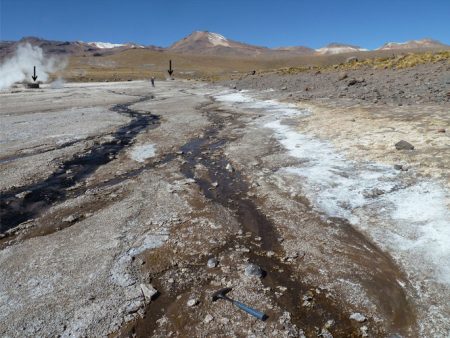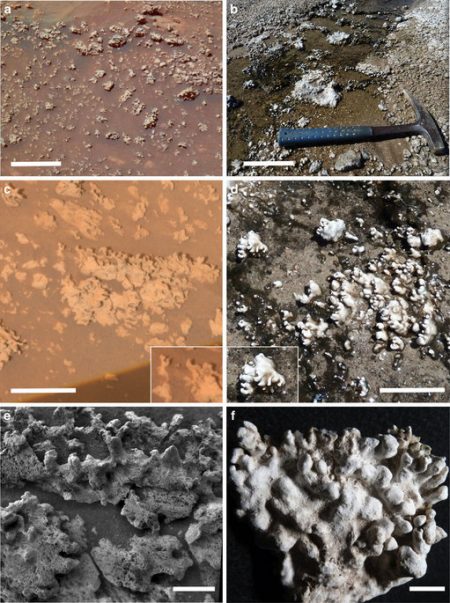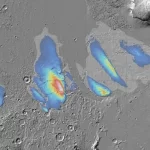November 24, 2016 – Published on November 17, 2016, in Nature Communications, researchers describe features in Gusev Crater on Mars that have a remarkable resemblance to hot spring sites found in El Tatio in Northern Chile. The physical comparison of the two sites is uncannily similar.
Spirit, the first of two Martian rovers which finally died when it got stuck in sand, found outcrops of nodular silica distributed across basaltic bedrock that resembles volcanic hydrothermal signatures here on Earth. On our planet we see this type of rock signature near no longer active hot springs and geysers. Such is the case in El Tatio, Chile.
When Spirit first rolled over the Gusev Crater site it used its thermal emission spectrometer to identify the silica in the rocks. The results from Gusev show qualitative similarities to the nodules at El Tatio. Seen below, El Tatio features hot springs, stone barricades and silica deposits in the middle of volcanic basalt deposits.
The next picture shows a comparison between opaline silica structures found at Gusev Crater with side-by-side images from El Tatio. The resemblance is uncanny. At El Tatio, the micro-environmental conditions created by microbial biofilm and mat communities thriving in water at temperatures greater than 40 Celsius (104 Fahrenheit) creates the shapes and nodular structures seen on the right. The images from Mars at similar scale appear nearly identical. Some of the rocks examined by Spirit appear to have similar porosity to what is seen at El Tatio to have been shaped by biology as well as by aeolian abrasion (wind).
Spirit arrived on Mars in January 2004, several weeks before its twin rover Opportunity. Spirit was the first to encounter opaline silica as it traced a route through Gusev Crater. Gusev Crater and El Tatio have some similar physical characteristics. El Tatio is located in a particular arid part of Chile and at a high elevation. The low precipitation rate, high evaporation, and extremes of heat and cold plus high ultraviolet irradiance makes it as close to a Martian landscape as any place on Earth.
The two authors of the paper, Steven Ruff and Jack Farmer, both at the School of Earth and Space Exploration, Arizona State University, write “Because we can neither prove nor disprove a biological origin for the microstromatolite-like digitate silica structures….they constitute a potential biosignature according to this definition.”
Spirit got stuck in soft Martian sand in May 2009 and finally died in May 2011. Opportunity is still chugging away 12 years after arriving on Mars and is now on the rim of Endeavour Crater. It too has discovered evidence of water on the surface of Mars having identified outcrops of calcium sulfate and gypsum at a place name Whitewater Lake. Curiosity, the next generation rover that joined its two predecessors, literally landed on a dried out river bed in Gale Crater.
The next rover to come to Mars, currently in planning for 2020, may provide a more definitive answer to the possible biological origin of the silica structures Spirit first identified. That successor to Curiosity will have the capability of obtaining and storing samples that can be returned to laboratories here on Earth to allow us to reach a definitive conclusion.

















